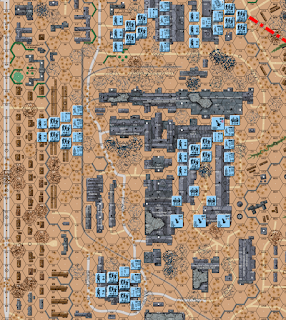Preamble
First off let me say thanks to MMP for publishing the Red October historical module for the ASL system. It's the sequel to the most successful CG in the entire ASL system: Red Barricades. I foresee many long hours of obsessive delight in my future.
That being said, it's become apparent to me that the playtesting of the various CGs contained within the module have left a bit to be desired. I've played CG I, X-Tag, and I've studied CG II Hubertus rather thoroughly, and I've concluded that they are both heavily stacked in favor of the German.
(A lack of play testing is a minor lapse, in my opinion. When one considers the time and effort required to play these massive games can we really expect multiple play testings by multiple players before release? It's we, the players of the game, upon whom the responsibility of play testing must necessarily fall. The publisher gives us the concept, we put it to the test.)
Of course, the original Red Barricades module had balance problems with its CGs, as well. As I've discussed on this blog before, the Barrikady campaign game is about 80% pro-Russian.
But Stewart King and I have an idea that we hope may prove to be a fun CG that involves the entirety of both the RB and RO boards and the entire OBs from both modules. I present our idea here.
 |
| All factories, plus 9 of the 12 objectives |
Fire on the Volga Campaign Game
Game length 17 Oct - 15 Nov
30 CG days
The entirety of both the RB and RO boards are used
CG VC: The German player wins if at the end of any CG day, there is a continuous German perimeter that includes all factories on both boards, plus the German controls all locations (even if isolated) 9 of the following 12 objectives:
RB board
- W9 (Chemist’s Shop)
- BB18 (Commissar’s House)
- GG21
- AA25
- V40
- V42
- V1
- Z8
- BB9
- All level 2 hill hexes (Slag Heap)
- GG23
- CC32
- No depletion rolls. Purchases at full strength.
- Whenever a reserve unit is activated by a German attack or by proximity of a German unit, all reserve units within 5 hexes of that unit are activated as well.
- For CCP replenishment, ignore all modifiers other than historical modifiers. Add 3 CPP to the result. Example: Russian player rolls 12. Historical modifier is 0. Result: 13 CPP. Add 3 CPP. Russian total for the day is 16CPP.
- Disregard the campaign balance provision.
- Each CPP spent on Fortifications is worth the following: German 40FFP, Russian 80FFP
- Whenever an armor platoon is recalled, the German receives 1 CPP for each surviving recalled tank with functioning MA and MGs on the following CG day.
- Russian RO CGI starting forces (including FPP but not any CPP) are deployed on the RO map as reserves starting on 17 Oct. They must be deployed as reserves on that map (though they may be repositioned before each CG day [EXC: Fortifications) until activated or the 23 Oct turn. On 23 October, they may be deployed on-map (either map) as desired. If the Germans enter the RO map at any time before 23 October, all RO reserves are immediately activated.
- The German RO CGI starting forces (though not the CPP from the RO CGI starting lineup) enter as reinforcements on 23 October. The German entry area includes all west edge hexes, plus any north edge hexes as per the RB rules, starting 23 October. Starting 23 October, both sides make 2 CPP replenishment rolls each CG day. Starting on 23 October, both sides may choose reinforcement groups up to the maximum allowed in RB CG III, RO CG I and RO CG II.
In effect, this CG begins as a normal RB CGIII game and proceeds as such until 23 October, eight CG days into the game. In my experience, 8 days in is just about where the Germans start to lose their steam. But in this case, on 23 October, the Germans get a big infusion of fresh troops.
When Hubertus comes, on 11 November, 3 days before the CG ends, the Germans will get their -3 historical modifier which may be the last bit of fuel they need to attain their objectives or to fall just short of them.
Who knows if this is balanced? But we think it will be fun. It will literally take years to complete this game, but what the hell? We're gamers, after all. If anyone else wants to give this a try, let us know! Stewart and I will be maintaining a blog of our game as we go along, so stay tuned...





